The AMD Radeon R9 290X Review
by Ryan Smith on October 24, 2013 12:01 AM EST- Posted in
- GPUs
- AMD
- Radeon
- Hawaii
- Radeon 200
Bioshock Infinite
Bioshock Infinite is Irrational Games’ latest entry in the Bioshock franchise. Though it’s based on Unreal Engine 3 – making it our obligatory UE3 game – Irrational had added a number of effects that make the game rather GPU-intensive on its highest settings. As an added bonus it includes a built-in benchmark composed of several scenes, a rarity for UE3 engine games, so we can easily get a good representation of what Bioshock’s performance is like.
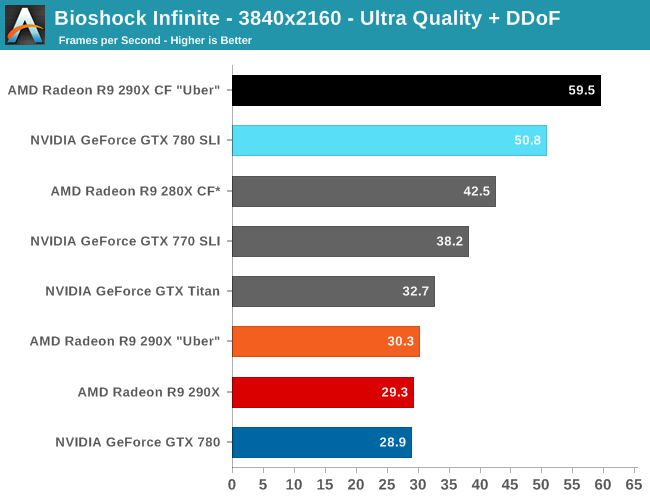

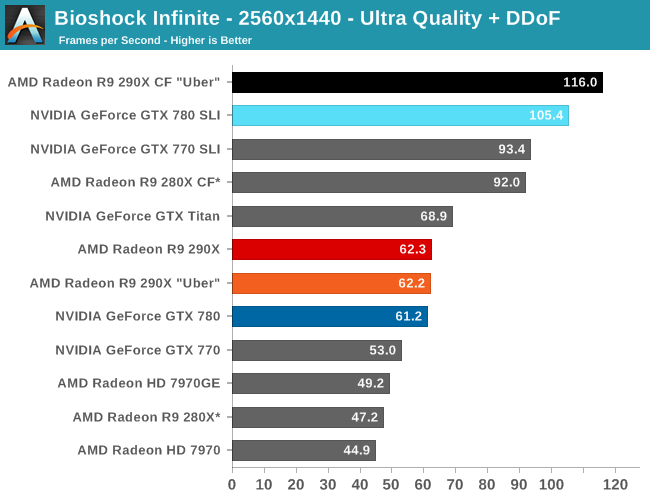
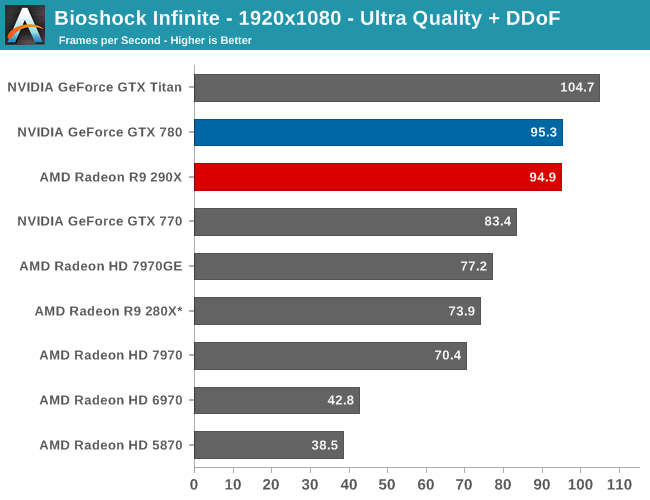
The first of the games AMD allowed us to publish results for, Bioshock is actually a straight up brawl between the 290X and the GTX 780 at 2560. The 290X’s performance advantage here is just 2%, much smaller than the earlier leads it enjoyed and essentially leaving the two cards tied, which also makes this one of the few games that 290X can’t match GTX Titan. At 2560 everything 290X/GTX 780 class or better can beat 60fps despite the heavy computational load of the depth of field effect, so for AMD 290X is the first single-GPU card from them that can pull this off.
Meanwhile at 4K things end up being rather split depending on the resolution we’re looking at. At Ultra quality the 290X and GTX 780 are again tied, but neither is above 30fps. Drop down to Medium quality however and we get framerates above 60fps again, while at the same time the 290X finally pulls away from the GTX 780, beating it by 14% and even edging out GTX Titan. Like so many games we’re looking at today the loss in quality cannot justify the higher resolution, in our opinion, but it presents another scenario where 290X demonstrates superior 4K performance.
For no-compromises 4K gaming we once again turn our gaze towards the 290X CF and GTX 780 SLI, which has AMD doing very well for themselves. While AMD and NVIDIA are nearly tied at the single GPU level – keep in mind we’re in uber mode for CF, so the uber 290X has a slight performance edge in single GPU mode – with multiple GPUs in play AMD sees better scaling from AFR and consequently better overall performance. At 95% the 290X achieves a nearly perfect scaling factor here, while the GTX 780 SLI achieves only 65%. Curiously this is better for AMD and worse for NVIDIA than the scaling factors we see at 2560, which are 86% and 72% respectively.
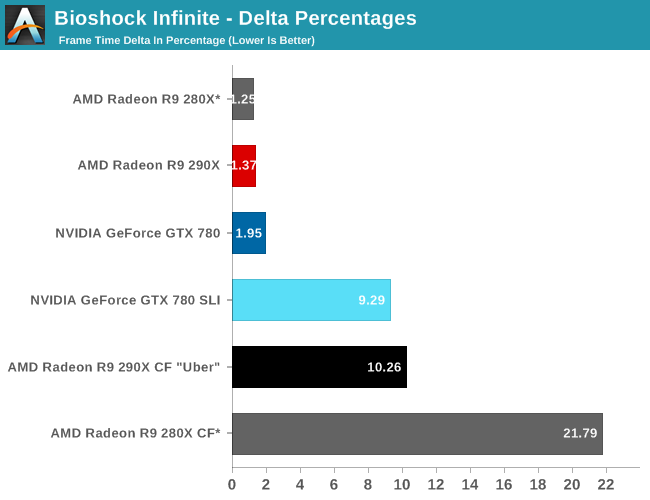

Moving on to our FCAT measurements, it’s interesting to see just how greatly improved the frame pacing is for the 290X versus the 280X, even with the frame pacing fixes in for the 280X. Whereas the 280X has deltas in excess of 21%, the 290X brings those deltas down to 10%, better than halving the variance in this game. Consequently the frame time consistency we’re seeing goes from being acceptable but measurably worse than NVIDIA’s consistency to essentially equal. In fact 10% is outright stunning for a multi-GPU setup, as we rarely achieve frame rates this consistent on those setups.
Finally for 4K gaming our variance increases a bit, but not immensely so. Despite the heavier rendering workload and greater demands on moving these large frames around, the delta percentages keep to 13%.


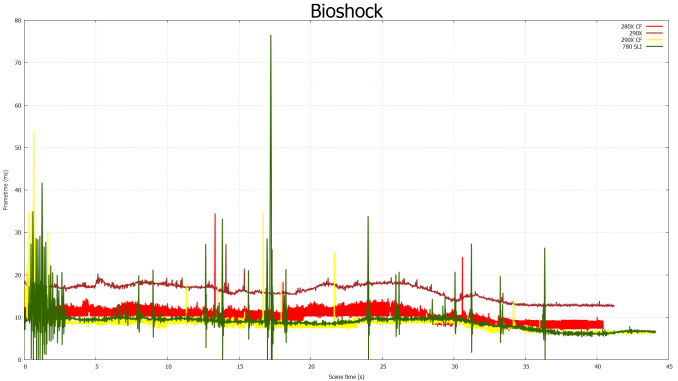









396 Comments
View All Comments
SirRaulo - Tuesday, October 29, 2013 - link
Game changer!A faster card and $100 cheaper... even an nvidia fanboy would know the difference.... wait, a fanboy wouldnt... too bad.
willis936 - Tuesday, October 29, 2013 - link
The game has changed twice a year for the past 20 years. If the change isn't changing one could argue that the game is staying the same.apaceeee - Tuesday, October 29, 2013 - link
Er...I don't think so ..polaco - Tuesday, October 29, 2013 - link
I have seen you used AMD Catalyst 13.11 (Beta 5) in the 290X benchmarks. Maybe would be nice if you can post some with the updated revision as they say to improve performance from 8% to 30% in several games.http://support.amd.com/en-us/kb-articles/Pages/lat...
Thanks!
Ryan Smith - Tuesday, October 29, 2013 - link
Those are versus Catalyst 13.9. There are no performance improvements in our game set between 13.11 v5 and v6.polaco - Tuesday, October 29, 2013 - link
Oh, ok if you say so. I got confused coz in one place it states that explicitly and in the other does not."Performance improvements for the AMD APU Series (comparing AMD Catalyst 13.11 Beta6 to AMD Catalyst 13.9)" in the other place doesn't make that clarification just
"Performance improvements"
wiyosaya - Wednesday, October 30, 2013 - link
Personally, I think it would have been interesting to see a GTX 580 thrown in for the compute benchmarks.rogerthat1945 - Thursday, October 31, 2013 - link
The ASUS GTX 780 went up in price $120+ USD for me last night when I was expecting a price drop thids morning.Last week (and all last month at least, the ASUS GTX 780 price was around $745 USD (in Yen) on Amazon Jp.
I put one in my shoping basket, and browsed some more for extra items (Zx Evo Headset considerations), and then heard about the NVidia cards price to be dropped for the GTX 780 range; so I held off going to checkout; however, this morning when I went to look at paying via the advertised price drop, BUT I found that Amazon have JACKED-UP the price to $867 US. :no:
http://www.amazon.co.jp/ASUSTeK-GTX780%E3%83%81%E3...
Question is;-
"Where can I buy this card for a `proper` price (which popular site) where they will POST it via Air Mail to Japan (not a US military address)? :ange:
Every site I tried from California to China do not post to Japan.
Amazon Japan, you are Kraaayyy-Zee crayon users. :pt1cable:
photek242 - Saturday, November 2, 2013 - link
Now i have a GTX 680 sli setup i think to sell the 2 cards and buy a AMD R290xOr stay with the sli setup?
Here in belgium the r290x goes between 465 - 550 euro
Tia
muziqaz - Sunday, November 3, 2013 - link
Ryan, I don't know if you are still reading this or not, but regarding Vegas Pro, I suppose other codecs do not use GPUs as expected. I use mp4 format and even though sony and AMD are telling me that GPUs do accelerate that format it actually do not. I can't even get my 12 thread CPU to be loaded fully. Or maybe there is another codec which is supported by youtube which might get some GPU acceleration if enabled? maybe someone else can pitch in with suggestions? :)